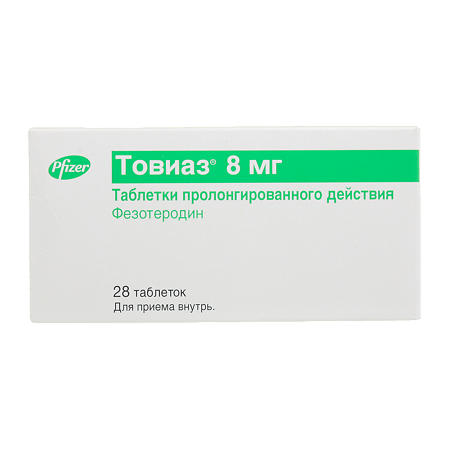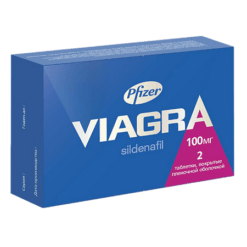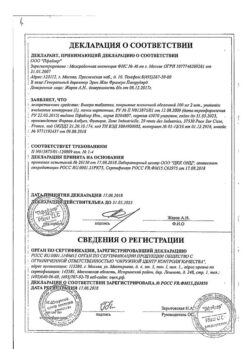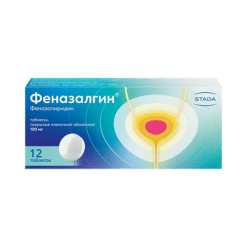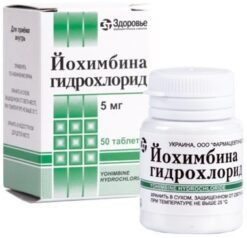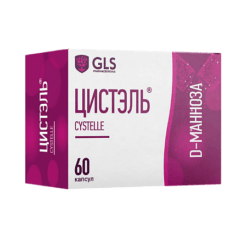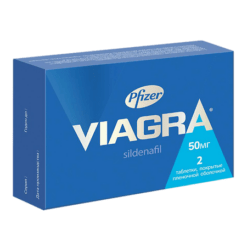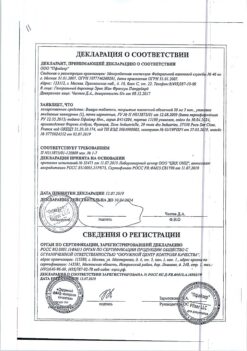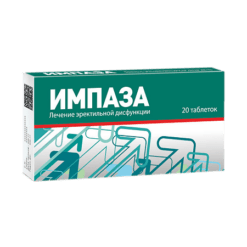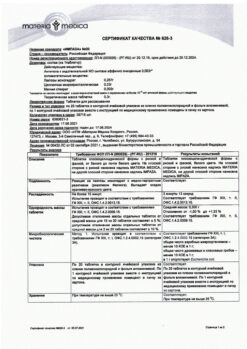No products in the cart.
Toviaz, 8 mg 28 pcs.
€34.34 €29.76
Description
Competitive inhibitor of m-cholinoreceptors.
Fesoterodine is rapidly and intensively hydrolyzed after oral administration with the participation of nonspecific esterases to form the active metabolite 5-hydroxymethyl tolterodine, which determines the m-cholinolytic activity of fesoterodine.
The activation of postganglionic parasympathetic m-cholinoreceptors of bladder smooth muscles induces detrusor contraction. Fezoterodine inhibits these receptors in the bladder, which is thought to produce the corresponding pharmacological effects.
The clinical use of fezoterodin has been shown to increase bladder volume by the time of the first detrusor contraction and to increase bladder capacity.
These effects increase in proportion to increasing dose.
Indications
Indications
Treatment of an overactive bladder in the presence of symptoms of acute urinary incontinence with the need for urgent and frequent urination.
Pharmacological effect
Pharmacological effect
Competitive inhibitor of m-cholinergic receptors.
After oral administration, fesoterodine is quickly and intensively hydrolyzed with the participation of nonspecific esterases to form the active metabolite 5-hydroxymethyl tolterodine, which determines the m-cholinolytic activity of fesoterodine.
Activation of postganglionic parasympathetic m-cholinergic receptors of bladder smooth muscle induces detrusor contraction. Fesoterodine inhibits these receptors in the bladder, which is believed to lead to the development of corresponding pharmacological effects.
Clinical use of fesoterodine has been shown to increase bladder volume at the time of the first detrusor contraction and increase bladder capacity.
These effects increase in proportion to increasing dose.
Special instructions
Special instructions
If angioedema develops, fesoterodine should be discontinued and appropriate therapy should be started immediately. In some cases, angioedema develops after the first dose.
Fesoterodine should be used with caution in patients with clinically significant narrowing of the bladder outlet, because there is a risk of urinary retention; in patients with decreased gastrointestinal motility (for example, severe constipation); in patients receiving treatment for angle-closure glaucoma, and only in cases where the expected benefit of therapy outweighs the possible risk; in patients with myasthenia gravis.
Patients should be monitored for symptoms of anticholinergic CNS effects, especially during treatment initiation and after dose increases. If such effects develop, you can reduce the dose or discontinue fesoterodine.
It is not recommended to use fesoterodine in patients with severe liver dysfunction, because Fesoterodine has not been studied in this category of patients.
It is not recommended to use fesoterodine in doses greater than 4 mg in patients receiving strong CYP3A4 inhibitors (including ketoconazole, itraconazole, clarithromycin).
When used simultaneously with moderate inhibitors of the CYP3A4 isoenzyme (for example, erythromycin, fluconazole, diltiazem, verapamil and grapefruit juice), no dose adjustment of fesoterodine is required.
The effect of weak inhibitors of the CYP3A4 isoenzyme (for example, cimetidine) has not been studied in clinical studies, however, some pharmacokinetic interaction should be expected, although less pronounced than when used with moderate CYP3A4 inhibitors.
Impact on the ability to drive vehicles and operate machinery
Patients who experience headache, dizziness, or drowsiness after taking fesoterodine should avoid driving or other potentially hazardous activities.
Active ingredient
Active ingredient
Fesoterodine
Composition
Composition
1 tab. fesoterodine 8 mg
Contraindications
Contraindications
Urinary retention, delayed gastric emptying, uncontrolled angle-closure glaucoma, hypersensitivity to fesoterodine.
Side Effects
Side Effects
From the digestive system: dry mouth, constipation, dyspepsia, nausea, vomiting, abdominal pain, increased activity of ALT and AST; in isolated cases – irritable bowel syndrome.
From the urinary system: urinary tract infections, dysuria, urinary retention.
From the respiratory system: cough, dry throat.
From the side of the organ of vision: dry eyes, blurred vision.
From the musculoskeletal system: back pain.
From the skin and subcutaneous fat: skin rash, itching.
Allergic reactions: angioedema with airway obstruction, facial swelling, urticaria.
From the central nervous system: dizziness, headache, drowsiness.
From the cardiovascular system: palpitation; in isolated cases – prolongation of the QTc interval on the ECG.
General reactions: peripheral edema.
Interaction
Interaction
When fesoterodine is used concomitantly with other anticholinergic drugs that cause dry mouth, constipation, urinary retention and other anticholinergic effects, the frequency and/or severity of such effects may increase. Anticholinergics may interfere with absorption when used concomitantly with certain drugs due to their anticholinergic effect on gastrointestinal motility.
Fesoterodine in doses greater than 4 mg is not recommended for use in patients receiving strong CYP3A4 inhibitors such as ketoconazole, itraconazole and clarithromycin. With the simultaneous use of ketoconazole and fesoterodine, the Cmax and AUC of 5-hydroxymethyl tolterodine, the active metabolite of fesoterodine, increases almost 2-fold.
Moderate CYP3A4 inhibitors do not have a clinically significant effect on the pharmacokinetics of fesoterodine. When used concomitantly with moderate CYP3A4 inhibitors (for example, erythromycin, fluconazole, diltiazem, verapamil and grapefruit juice), no dose adjustment is required.
With simultaneous use of fesoterodine at a dose of 8 mg and the CYP3A4 inducer rifampin at a dose of 600 mg 1 time / day, the Cmax and AUC of the active metabolite of fesoterodine decreases by approximately 70% and 75%, respectively, while the T1/2 of the active metabolite does not change.
In individuals with reduced CYP2D6 metabolism, with maximum inhibition of CYP2D6, the Cmax and AUC of the active metabolite of fesoterodine increases by 1.7 and 2 times, respectively. When used concomitantly with CYP2D6 inhibitors, no dose adjustment is required.
Manufacturer
Manufacturer
Eisika Pharmaceuticals GmbH, Germany
Additional information
| Manufacturer | Eisika Pharmaceuticals GmbH, Germany |
|---|---|
| Medication form | sustained release tablets |
| Brand | Eisika Pharmaceuticals GmbH |
Related products
Buy Toviaz, 8 mg 28 pcs. with delivery to USA, UK, Europe and over 120 other countries.

